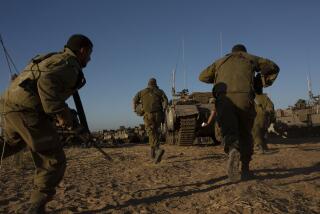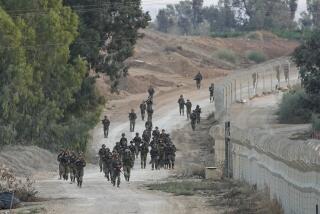Tank Wizard’s Advice: Play the Terrain : Military: Israeli general says it is easier to fight from a defensive position.
- Share via
JERUSALEM — Erwin Rommel, Heinz Guderian, George S. Patton Jr.--they were his military mentors. And like them, Maj. Gen. Avraham Adan became a master of armored warfare.
In the Arab-Israeli War of 1956, as a battalion commander, Adan directed a key battle in the Sinai Desert campaign that led to the breakthrough to the Suez Canal. In 1967, his brigade spearheaded the attack across the Sinai. And in 1973, he commanded the tank division that crossed the Suez Canal and, racing south, encircled the 3rd Egyptian Army.
Adan--he is called “Bren,” after the Bren gun he carried in the 1948-49 Israeli War of Independence--is 64 now, but he is still on call in case of war.
Short, wiry and reserved, he talked with a reporter the other day about the problems that American tank forces will face if they go to war with the Iraqis in the sands of the Arabian Peninsula.
The desert, he said, is neutral. It is up to the tank commanders to take advantage of the terrain.
“Remember that the desert is not as flat as it looks,” he said. “There are hills and depressions and you can hide your tanks--though when moving, the dust clouds can be seen for miles.”
Although Adan is known as a master of the lightning, sweeping, flanking movement--which he employed after crossing the Suez Canal in the 1973 war--he said it is easier to fight from a defensive position.
“It’s a big advantage,” he said. “It is better, more accurate, to shoot from a defensive position than when you are moving. If you can keep your tanks hull down, you can do a lot of damage to enemy tanks coming your way.”
Adan also said it is dangerous to commit armor piecemeal, rather than concentrating it for maximum effect.
In the first, desperate days of the 1973 war, Israeli desert forces were whittled away in individual attacks against advancing Egyptians and took severe casualties. Then, the Israeli commanders changed tactics. They waited for the Egyptians to begin a massive attack along the entire front, touching off the biggest tank battle since World War II.
Sharpshooting Israeli tanks, hull down in desert depressions, picked off the enemy tanks one by one, dozens upon dozens, and wiped out entire formations.
Still, Adan said, “eventually you must attack in order to take land and destroy the enemy’s rear.”
Once the United States has heavy armor in place to defend the oil fields of Saudi Arabia, Adan said, this should give them the advantage in any thrust south by Iraqi armor.
Adan also emphasized the role of air power, which the United States has been quick to deploy in Saudi Arabia.
“In the wide-open desert, where there is no place to hide, you must achieve air superiority,” he said. “Ground operations will be very much influenced by control of the air.”
Israel’s armored forces had grown accustomed to having air superiority after the wars of 1956 and 1967. But in the 1973 war, they found that their jets were being shot out of the sky with Soviet-supplied surface-to-air missiles.
“That is where combined arms comes in,” Adan said. “In 1973, we thought the tanks could do everything. But Egyptian infantrymen had good anti-tank missiles and did much damage.”
By and large, Adan believes that the Americans “don’t need much advice.” He said: “They have studied our wars, as have we. They know the desert is open, tankable terrain, where you can mass armor and move quickly. I think they have studied the lessons and will learn to adapt to the circumstances.”
More to Read
Sign up for Essential California
The most important California stories and recommendations in your inbox every morning.
You may occasionally receive promotional content from the Los Angeles Times.













